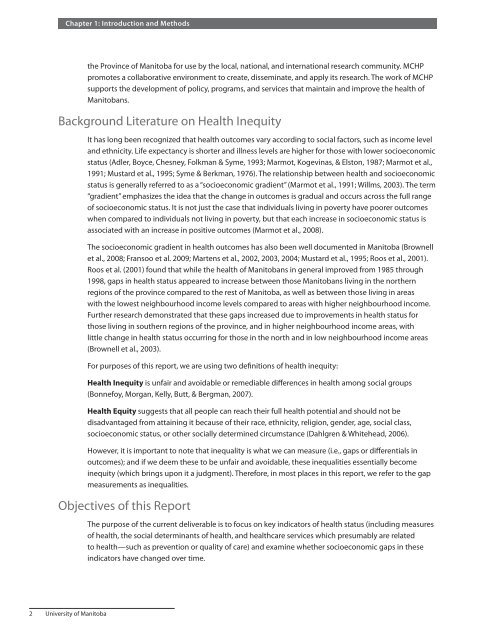Health Inequities in Manitoba: Is the Socioeconomic Gap
Health Inequities in Manitoba: Is the Socioeconomic Gap
Health Inequities in Manitoba: Is the Socioeconomic Gap
You also want an ePaper? Increase the reach of your titles
YUMPU automatically turns print PDFs into web optimized ePapers that Google loves.
Chapter 1: Introduction and Methods<br />
2 University of <strong>Manitoba</strong><br />
<strong>the</strong> Prov<strong>in</strong>ce of <strong>Manitoba</strong> for use by <strong>the</strong> local, national, and <strong>in</strong>ternational research community. MCHP<br />
promotes a collaborative environment to create, dissem<strong>in</strong>ate, and apply its research. The work of MCHP<br />
supports <strong>the</strong> development of policy, programs, and services that ma<strong>in</strong>ta<strong>in</strong> and improve <strong>the</strong> health of<br />
<strong>Manitoba</strong>ns.<br />
Background Literature on <strong>Health</strong> Inequity<br />
It has long been recognized that health outcomes vary accord<strong>in</strong>g to social factors, such as <strong>in</strong>come level<br />
and ethnicity. Life expectancy is shorter and illness levels are higher for those with lower socioeconomic<br />
status (Adler, Boyce, Chesney, Folkman & Syme, 1993; Marmot, Kogev<strong>in</strong>as, & Elston, 1987; Marmot et al.,<br />
1991; Mustard et al., 1995; Syme & Berkman, 1976). The relationship between health and socioeconomic<br />
status is generally referred to as a “socioeconomic gradient” (Marmot et al., 1991; Willms, 2003). The term<br />
“gradient” emphasizes <strong>the</strong> idea that <strong>the</strong> change <strong>in</strong> outcomes is gradual and occurs across <strong>the</strong> full range<br />
of socioeconomic status. It is not just <strong>the</strong> case that <strong>in</strong>dividuals liv<strong>in</strong>g <strong>in</strong> poverty have poorer outcomes<br />
when compared to <strong>in</strong>dividuals not liv<strong>in</strong>g <strong>in</strong> poverty, but that each <strong>in</strong>crease <strong>in</strong> socioeconomic status is<br />
associated with an <strong>in</strong>crease <strong>in</strong> positive outcomes (Marmot et al., 2008).<br />
The socioeconomic gradient <strong>in</strong> health outcomes has also been well documented <strong>in</strong> <strong>Manitoba</strong> (Brownell<br />
et al., 2008; Fransoo et al. 2009; Martens et al., 2002, 2003, 2004; Mustard et al., 1995; Roos et al., 2001).<br />
Roos et al. (2001) found that while <strong>the</strong> health of <strong>Manitoba</strong>ns <strong>in</strong> general improved from 1985 through<br />
1998, gaps <strong>in</strong> health status appeared to <strong>in</strong>crease between those <strong>Manitoba</strong>ns liv<strong>in</strong>g <strong>in</strong> <strong>the</strong> nor<strong>the</strong>rn<br />
regions of <strong>the</strong> prov<strong>in</strong>ce compared to <strong>the</strong> rest of <strong>Manitoba</strong>, as well as between those liv<strong>in</strong>g <strong>in</strong> areas<br />
with <strong>the</strong> lowest neighbourhood <strong>in</strong>come levels compared to areas with higher neighbourhood <strong>in</strong>come.<br />
Fur<strong>the</strong>r research demonstrated that <strong>the</strong>se gaps <strong>in</strong>creased due to improvements <strong>in</strong> health status for<br />
those liv<strong>in</strong>g <strong>in</strong> sou<strong>the</strong>rn regions of <strong>the</strong> prov<strong>in</strong>ce, and <strong>in</strong> higher neighbourhood <strong>in</strong>come areas, with<br />
little change <strong>in</strong> health status occurr<strong>in</strong>g for those <strong>in</strong> <strong>the</strong> north and <strong>in</strong> low neighbourhood <strong>in</strong>come areas<br />
(Brownell et al., 2003).<br />
For purposes of this report, we are us<strong>in</strong>g two def<strong>in</strong>itions of health <strong>in</strong>equity:<br />
<strong>Health</strong> Inequity is unfair and avoidable or remediable differences <strong>in</strong> health among social groups<br />
(Bonnefoy, Morgan, Kelly, Butt, & Bergman, 2007).<br />
<strong>Health</strong> Equity suggests that all people can reach <strong>the</strong>ir full health potential and should not be<br />
disadvantaged from atta<strong>in</strong><strong>in</strong>g it because of <strong>the</strong>ir race, ethnicity, religion, gender, age, social class,<br />
socioeconomic status, or o<strong>the</strong>r socially determ<strong>in</strong>ed circumstance (Dahlgren & Whitehead, 2006).<br />
However, it is important to note that <strong>in</strong>equality is what we can measure (i.e., gaps or differentials <strong>in</strong><br />
outcomes); and if we deem <strong>the</strong>se to be unfair and avoidable, <strong>the</strong>se <strong>in</strong>equalities essentially become<br />
<strong>in</strong>equity (which br<strong>in</strong>gs upon it a judgment). Therefore, <strong>in</strong> most places <strong>in</strong> this report, we refer to <strong>the</strong> gap<br />
measurements as <strong>in</strong>equalities.<br />
Objectives of this Report<br />
The purpose of <strong>the</strong> current deliverable is to focus on key <strong>in</strong>dicators of health status (<strong>in</strong>clud<strong>in</strong>g measures<br />
of health, <strong>the</strong> social determ<strong>in</strong>ants of health, and healthcare services which presumably are related<br />
to health—such as prevention or quality of care) and exam<strong>in</strong>e whe<strong>the</strong>r socioeconomic gaps <strong>in</strong> <strong>the</strong>se<br />
<strong>in</strong>dicators have changed over time.


